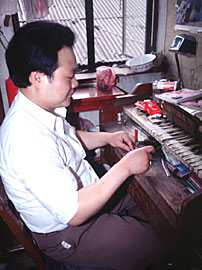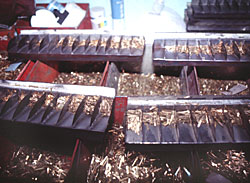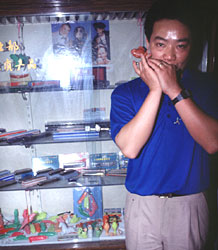A Shanghai Secret
For decades, most of the world's harmonicas have been produced on the sly by a state factory in Shanghai, even though the best harp players had no idea where the Huangs came from - until now
By Ron Gluckman / Shanghai
A
MAGICAL MELODY WAFTS OVER THE METALIC din of lathes and drills in a dark, unmarked Shanghai warehouse. To the uninformed ear, it sounds like an orchestra sans synchrony. But to officials at the Shanghai General Harmonica Plant, these are the chart-topping strains of success. While joint ventures from Harbin to Shenzhen struggle to break even, the state-owned
Shanghai General Harmonica Plant has humbly turned a profit for decades by focusing on one
product only. More than 10 million harmonicas roll out of the cacophonous factory every
year.
While joint ventures from Harbin to Shenzhen struggle to break even, the state-owned
Shanghai General Harmonica Plant has humbly turned a profit for decades by focusing on one
product only. More than 10 million harmonicas roll out of the cacophonous factory every
year.
"There are seven harmonica factories in China, but this is the largest," says director Chen Di Bin, smiling and displaying a set of teeth as shiny as chrome side-plating. "But nobody knows about us."
The Shanghai factory turns out instruments played by stars like Stevie Wonder and session stalwarts such as Norton Buffalo, an in-demand California player with 100 recordings to his credit.
Buffalo concocted the hot harp solo that sent a cover version of the old rock song "Runaway" racing up the charts for Bonnie Raitt's first hit. Buffalo frequently appears in promotional ads for his friends Cham-Ber and Frank Huang, president and vice president respectively of Insignia International Inc. in Amityville, N.Y., which has most of its Huang brand harmonicas made at the factory.
Two of Huang's top rivals have been through the same doors. The Shanghai General factory, established in 1939 and turned over to the state in 1954, also makes harmonicas for Suzuki Musical Instruments Manufacturing Co., according to Chen, and once produced over half a million harmonicas every year for Hohner Vertrieb GmbH, the German company that has long dominated the market.
Hohner's business was delegated in 1988 to another Shanghai-based state enterprise, the Shanghai Dong Fang Musical Instrument Factory. By then, Shanghai General had entered into a deal to make Huang harmonicas for exclusive export to America.
Shanghai-born Cham-Ber Huang became the first American allowed inside the factory, Chen says. The visit by this reporter, he says, represents the first time a reporter has ever visited the factory.
In recent years the factory has adopted a more open-door policy. "We welcome visitors," says Chen. The major harmonica-makers, however, keep as quiet as possible about the location of their production facilities on the grounds that the image of China as a producer of cheap goods might be detrimental.
Chen says that the finer Suzuki models are shipped with the country of origin on paper wrapping only, not imprinted on the harmonica itself. Suzuki's export manager says he knows nothing of this practice.
Werner Lips, purchasing manager of Hohner in Trossingen, claims that all harmonicas made in China are labeled to that effect, but Cheng Min Gen, director of the Dong Fang factory, says that Hohner usually doesn't want the country of origin stamped on their harmonicas that are exported to Germany. (It is legal to ship goods into some countries with just a removable document showing origin.)
Yet there seems to be no lack of fine craftsmanship on Zhongxing Road in northwestern
Shanghai, where technicians wield optician-sized tools in a complex process that involves
more than 100 steps. In a dozen cramped rooms no wider than hallways, the plant's most
discerning ears are pressed close to keyboards, while deft hands move harmonicas over
bellows, meticulously matching each note to the exact keyboard tone.
"Perhaps as many as 5 percent of the harmonicas are rejected in this final check," says Chen.
In addition to the Huang and Suzuki models, the factory produces a large volume of cheap plastic toy tooters popular with Chinese children. Eight million toy models leave the factory each year, many of them in dog, swan, fish, banana and revolver shapes. The company also issues nearly a dozen of its own quality models under such names as Star, Victory, Lark, Shanghai and Friendship.
Chen says the majority are 24-hole models selling for about $1.75 to $2. These are in big demand in China, but used only by polka bands elsewhere. Most Western players prefer 10-hole models. The plant also makes what Chen claims is the world's largest harmonica, a high-caliber 48-hole harp that is nearly two-feet wide.
Like spaghetti and the compass, the harmonica descends from a Chinese invention, or so the Chinese claim. Considered to be an instrument for the people by virtue of its low cost, ease of mastery, and portability, it evolved from an ancient flute-like instrument called the sho na.
"Even Mao was said to favor the harmonica," says Chen. It was very popular during the 1940s and 1950s, but fell from favor during the Cultural Revolution, when the performance of music was strictly limited. Now it is back.
"It seems to move in cycles," says Chen. "Why? Look at the piano. It's so expensive to buy the instrument and pay for lessons. Recently, the government issued a requirement that children learn some instrument. The harmonica is among those suggested -- the harmonica and Chinese flute."
Assembly-line workers arrive not long after dawn and step over stacks of brass strips. These are cut to the right width, then hammered to the proper thickness. The raw materials begin to take shape as slots are cut into the metal plates, holes drilled and reeds inserted as the products move from room to room, always gravitating upstairs. The final testing and packing are completed on the fifth floor.
Huang harmonicas are crafted over a two-to-three-month period, although Chen estimates that the actual time for construction of a dozen Huang blues harmonicas averages eight hours. The most complicated part of assembly involves attaching the 20 tiny metal reeds, 10 each on the top and bottom, to these metal plates. The paper-thin reeds vary in length but all are about the width of a shoelace and no longer than a thumbnail. These must be drilled, then screwed into place. Maneuvering the screws with precision tools allows workers to align the reeds at one of many quality-control checkpoints.
About half of the 500-odd factory employees are women. "Women are slower, more careful than men," Chen says. The heavy equipment on the first floor, however, is all operated by men. During Asia, Inc.'s visit safety posters were observed on many walls, but workers wore no protective devices and guards were not seen on any equipment, including metal cutters.
 In a category by themselves are a handful of staff harmonica players, trained in an
intensive in-house program. Zhang Zi Jing, 33, learned to play when he joined the company
in 1980 and became the factory's star, winning top honors in a number of local and
national competitions.
In a category by themselves are a handful of staff harmonica players, trained in an
intensive in-house program. Zhang Zi Jing, 33, learned to play when he joined the company
in 1980 and became the factory's star, winning top honors in a number of local and
national competitions.
Zhang says he'd like to learn country and blues tunes. Unfortunately, this Western musical form is unavailable on tapes in China. Not that Zhang is singing his own blues. He has had a cushy job, spending much of his time playing for company promotions, and is currently trying to promote the factory's wares in South Africa.
Chen is hoping that this particular Chinese musical contribution will become more widely recognized.
"The world doesn't know this factory, but everyone plays our harmonicas," Chen says, proudly tooting his own horn. "If they knew, they would all buy from China."
Ron Gluckman is an amateur harmonica player as well as a journalist who travels widely around the Asian region for a variety of publications, including Asia, Inc., which ran this story in 1994. It has been widely reprinted.
To return to the opening page and index
push here
[right.htm]
